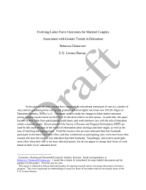Evolving Labor Force Outcomes for Married Couples Associated with Gender Trends in Education
Evolving Labor Force Outcomes for Married Couples Associated with Gender Trends in Education
Abstract
In the past two decades, women have surpassed the educational attainment of men in a number of ways and are graduating from college and graduate school at higher rates than men (NCES, Digest of Education Statistics, 2009 a, b, c). This paper seeks to study the changes in labor market outcomes among married couples based on their level of education relative to their spouse. In particular, this paper focuses on how labor force participation, work hours, and work absences vary with the mix of education within a married couple. Recent panels of the Survey of Income and Program Participation (SIPP) are used for this study because of the wealth of information about earnings and labor supply, as well as the ease of matching marriage partners. I find that women who are more educated than their husbands participate in the labor force more often, and that, conditional on participating, they work more hours than women who have the same or less education than their husbands. Surprisingly, men tend to participate more often when their wife is the more educated spouse, but do not appear to change their hours of work based on their wives’ education level.
Others in Series
Working Paper
Working Paper
Working Paper




